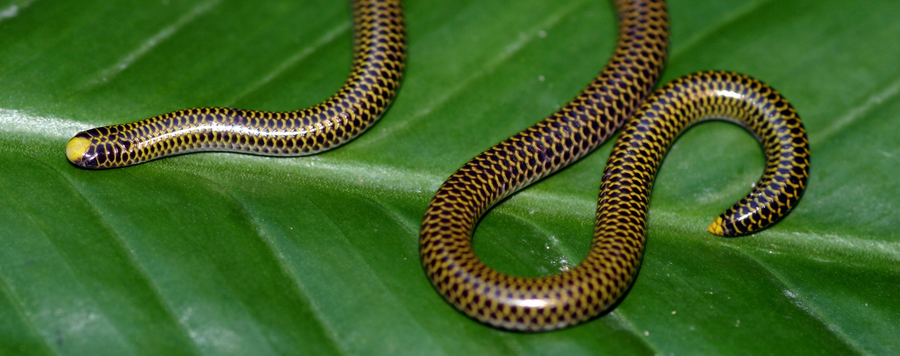The most ancient but highly specialized clade of snakes form the superfamily Scolecophidia, the so called blindsnakes with about 452 species divided into 5 families. In this group of snakes strong selection associated with a fossorial lifestyle has led to cranial consolidation, miniaturization, and body elongation, resulting in worm-like habits – usually less than 30 cm in total length, and tiny skulls – often just a few millimeters long. Most species look superficially alike and it is almost impossible to correctly determine the species without further examination and a profound knowledge of the group. Thus, among all snakes, the scolecophidians are unsurpassed in difficulty of identification due to their low number in diagnostic characters, difficulties in accurately illustrating and collecting morphological data due to their small sizes. Furthermore, due to their subterranean habitat, nocturnal lifestyle, and small size, these snakes are extremely difficult to find in the field and seldom are collected. This results in rare observations on wild individuals, a lack of information of live coloration in many species, and a paucity of specimens in museum collections. Knowledge on ecology, phylogeny, distributional ranges, and intraspecific variation is insufficient in many species of blindsnakes, and discrepancies still exist on the exact number of currently recognized species within this group. Both, biologically and taxonomically, the scolecophidians are the most difficult and poorest known group of snakes with a greatly underestimated worldwide biodiversity. Of the two major families within the group, the family Leptotyphlopidae is the least studied. Nearly all systematic work on the family has been the description of new species, mainly solely based on external morphological characters . Only very few phylogenetic analyses —morphological or molecular— have so far been published on Leptotyphlopidae. These studies included only a fraction of the species which are mainly represented by just a single specimen that does neither represent type material nor was it collected from near the type locality of the respective species. Nevertheless, recent analyses uncovered hidden cryptic diversity in the Leptotyphlopidae, i.e. two or more distinct species that were classified as a single species as a result of their morphological similarity. Most of this hidden diversity consists of similar-looking and superficially identical snakes, with meristic characters largely overlapping and, as with many morphologically cryptic taxa, there is a reliance on a limited suite of diagnostic characters to differentiate species. These are usually external traits such as shape and scalation of the head, mid-body scale rows and dorsal or ventral scale counts. Thus, there is a strong need for the discovery of further distinguishing characters of systematic and taxonomic value. Due to their small size only exemplary examinations of the skulls of the different genera and species exist and have so far not been used as diagnostic characters. On several genera no published data is so far available on the dorsal skull morphology.
Fortunately, modern techniques, such as µCT-technology have become more and more available and allow 3D-reconstructions of the skeletal anatomy, without the need to dissect the specimen. Although this non-invasive technique allows the sampling of several specimens with no damage to any specimen of the series, and in little time, up to now the skulls of only three species (Rena dulcis, Trilepida salgueiroi, T. pastusa) of Leptotyphlopidae have been examined by use of this approach and only a single specimen per species has been ct-scanned.
During this project we will use this modern µCT-technology to reconstruct relevant morphological characters to clarify in combination with phylogenetic DNA analysis the identity and position of different blindsnake species.
Published results from this project:
Journal articles:
Koch, C., Martins, A., Schweiger, S. (2019): A century of waiting: description of a new Epictia Gray, 1845 (Serpentes: Leptotyphlopidae) based on specimens housed for more than 100 years in the collection of the Natural History Museum Vienna (NMW). PeerJ 7:e7411.
Martins, A., Koch, C., Pinto, R., Folly, M., Fouquet, A., Passos, P. (2019): From the inside out: Discovery of a new genus of threadsnakes based on anatomical and molecular data, with discussion of the leptotyphlopid hemipenial morphology. Journal of Zoological Systematics and Evolutionary Research 57: 840-863.
Koch, C., Santa Cruz, R., Cárdenas, H. (2016): Two new endemic species of Epictia Gray, 1845 (Serpentes: Leptotyphlopidae) from Northern Peru. Zootaxa 4150: 101-122.
Koch, C., Venegas, P.J., Böhme, W. (2015): Three new endemic species of Epictia Gray, 1845 (Serpentes: Leptotyphlopidae) from the dry forest of northwestern Peru. Zootaxa 2964: 228-244.
Oral presentations:
Koch, C. (2017): Diversity of South American wormsnakes of the genus Epictia: Analysis of external and internal morphological characters via Micro-CT images. Latinamerican Congress of Herpetology, Quito, Ecuador.
Koch, C. (2017): Diversity of South American wormsnakes of the genus Epictia: Analysis of internal morphological characters via Micro-CT images. SEH Congress (European Society of Herpetology), Salzburg, Austria.
Supervised thesis:
Joshi, M. (2019): Comparative osteology of the blindsnake family Leptotyphlopidae (Squamata: Serpentes: Scolecophidia). MSc thesis, University of Bonn.
Müller, P. (2019): Diversity of leptotyphlopid Blindsnakes from the Yemen. BSc thesis, University of Bonn.
Rech, I. (2019): Comparative studies on the skull morphology of Typhlopid blindsnakes (Serpentes: Typhlopidae) via CT-Scan. BSc thesis, University of Bonn.
Schwarz, N. (2017): Comparative studies via CT-scan on blind snakes of the genus Epictia (Gray, 1845) and other Epictinae (Serpentes: Leptotyphlopidae: Epictinae). BSc Thesis, University of Bonn (Co-supervised with Prof. Dr. Wolfgang Wägele).
Börth, M. (2017): Systematik und Morphologie afrikanischer Schlankblindschlangen (Serpentes: Leptotyphlopinae) unter besonderer Berücksichtigung der kranialen Osteologie. BSc Thesis, University of Bonn (Co-supervised with Prof. Dr. Wolfgang Wägele).








